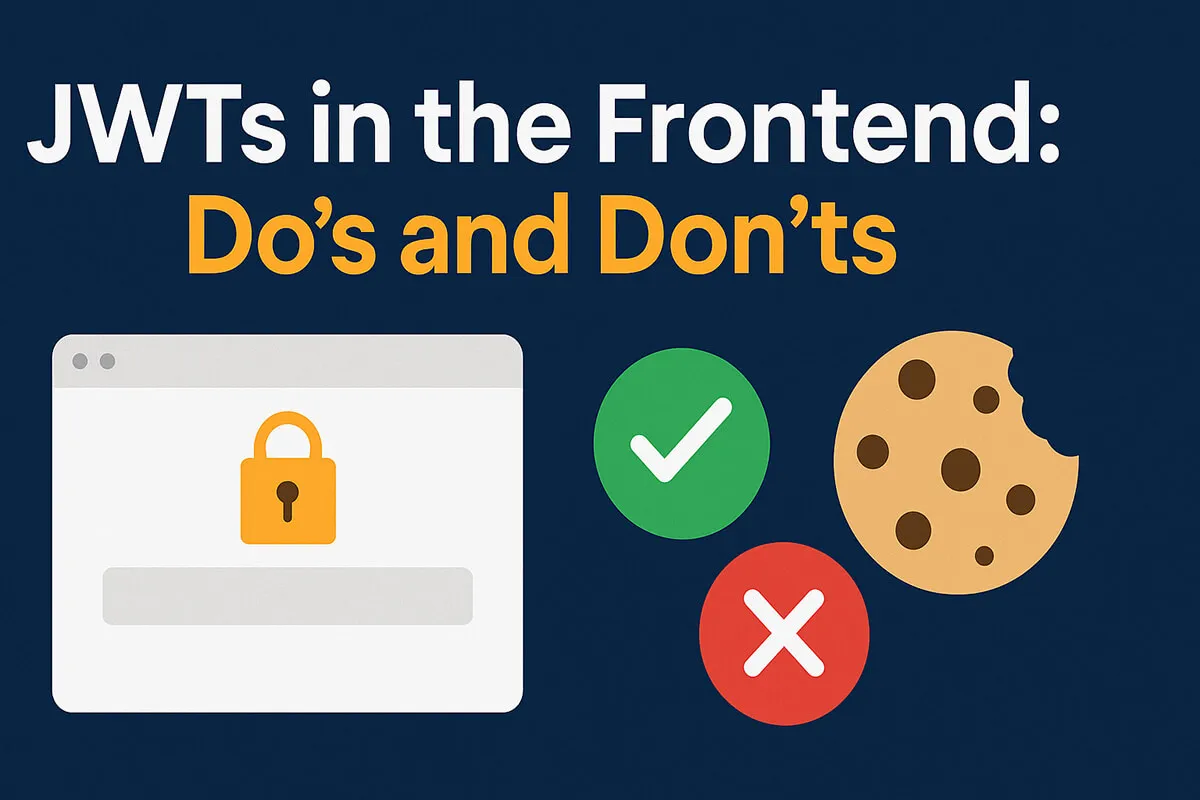Stop putting JWTs in localStorage: a fun, practical guide for frontend apps
A hands-on, example-packed guide to storing and refreshing JWTs safely in frontend apps: in-memory access tokens, HttpOnly refresh cookies, rotation, CORS/CSRF, and real code you can ship.

🍪 JWTs in the Frontend: Do’s, Don’ts, and “Oh No!”s
So you’ve got JWTs in your app. Great! But how and where you store them can be the difference between “🎉 Secure app” and “💀 Oops, we leaked tokens on Pastebin.”
❌ Don’t: Put JWTs in localStorage
// 🚨 BAD PRACTICE
localStorage.setItem('token', accessToken);-
Why it’s bad:
- XSS = game over. Any malicious script can
localStorage.getItem('token'). - Tokens persist across refreshes and tab closings, which makes them a juicy target.
- No easy way to log users out across tabs.
- XSS = game over. Any malicious script can
Imagine: You proudly ship your SPA. One day a marketing script has a sneaky bug, and suddenly attackers are sipping your users’ tokens like iced lattes. ☕💸
✅ Do: Keep Access Tokens in Memory
let accessToken: string | null = null;
export function setAccessToken(token: string) {
accessToken = token;
}
export function getAccessToken() {
return accessToken;
}- Short-lived (5-15 min).
- Wiped out when you refresh or close tab.
- If stolen, attacker has very little time to use it.
✅ Do: Put Refresh Tokens in HttpOnly Cookies
Server sets it like:
res.cookie('refresh_token', refreshToken, {
httpOnly: true,
secure: true,
sameSite: 'lax',
path: '/auth/refresh',
maxAge: 30 * 24 * 60 * 60 * 1000, // 30 days
});- HttpOnly → JavaScript can’t touch it 🛡️
- Secure → only over HTTPS 🌐
- SameSite → reduces CSRF 💪
Note on SameSite:
- Use
laxfor most SPAs served from the same site or subdomain. - Use
strictif your app never needs cross-site navigation with cookies (most restrictive). - Use
none+secure: trueif your API is on a different site (not just a subdomain) and you need cross-site requests.
Security tip: Rotate the refresh token on every refresh and detect reuse server-side. Invalidate the old token so a stolen one can’t be replayed.
🔄 After Refreshing the Tab
- Access token in memory? Gone. Poof. 🪄
- Refresh token cookie? Still there, browser keeps it. 🍪
So on app boot:
// bootstrap.ts
try {
const res = await axios.post('/auth/refresh', null, { withCredentials: true });
setAccessToken(res.data.accessToken);
} catch {
setAccessToken(null);
redirectToLogin();
}Result: User stays logged in like nothing happened.
⚔️ Pitfalls & How to Avoid Them
| Pitfall | Why it’s bad | Fix |
|---|---|---|
| Long-lived Access Tokens | If stolen, attacker gets days of free access | Keep AT short (≤15 min) |
| Refresh Token in JS storage | Equivalent to leaving your house key under the mat | Always cookie (HttpOnly + Secure + SameSite) |
Wildcard CORS (*) with credentials | Any site could make requests with your cookies | Strictly whitelist origins |
| Not rotating refresh tokens | If one leaks, attacker reuses forever | Rotate RT on every refresh |
| Ignoring CSRF | If cookies auto-send on cross-site POST | Add CSRF tokens for cookie-based auth endpoints |
📝 Example “Do and Don’t” Cheatsheet
✅ Do this:
// Create an axios instance with cookies enabled
const api = axios.create({ withCredentials: true });
let isRefreshing = false;
let pendingRequests = [] as Array<(token?: string) => void>;
api.interceptors.request.use((config) => {
const token = getAccessToken();
if (token) config.headers.Authorization = `Bearer ${token}`;
return config;
});
api.interceptors.response.use(undefined, async (error) => {
const status = error.response?.status;
const original = error.config || {};
// Don't try to refresh if the refresh endpoint itself failed
const isRefreshCall = typeof original.url === 'string' && original.url.includes('/auth/refresh');
if (status === 401 && !original._retry && !isRefreshCall) {
(original as any)._retry = true;
if (isRefreshing) {
return new Promise((resolve) => {
pendingRequests.push((newToken) => {
if (newToken) {
original.headers = { ...original.headers, Authorization: `Bearer ${newToken}` };
}
resolve(api(original));
});
});
}
isRefreshing = true;
try {
const { data } = await api.post('/auth/refresh', null); // cookie sent automatically
setAccessToken(data.accessToken);
pendingRequests.forEach((cb) => cb(data.accessToken));
pendingRequests = [];
original.headers = { ...original.headers, Authorization: `Bearer ${data.accessToken}` };
return api(original);
} catch (e) {
pendingRequests.forEach((cb) => cb());
pendingRequests = [];
setAccessToken(null);
redirectToLogin();
return Promise.reject(e);
} finally {
isRefreshing = false;
}
}
return Promise.reject(error);
});❌ Don’t do this:
// Storing in localStorage
const token = localStorage.getItem('accessToken');
fetch('/api/user', { headers: { Authorization: `Bearer ${token}` } });🛡️ Extra Defenses
- Content-Security-Policy → block inline JS.
- Trusted Types (Chrome) → block XSS sinks.
- Don’t put tokens in URLs → they end up in logs & analytics.
- BroadcastChannel → cross-tab logout sync.